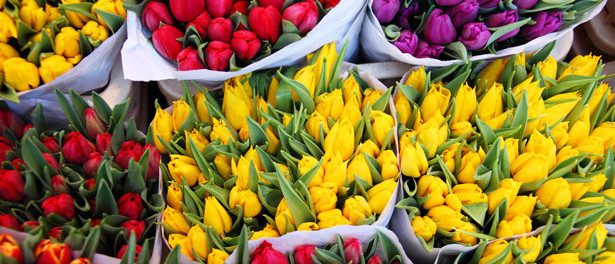How to Make Your Valentine’s Day Healthy

In the US and other parts of the world (including Canada, Mexico, Japan, Denmark, and Australia), February 14 is a day for celebrating loved ones. The tradition dates back to ancient Roman times, when it’s said a Saint Valentine would help people escape from Roman prisons, where they were often tortured.
One legend has it that Valentine was imprisoned himself and sent a letter professing his love for the jailor’s daughter before his death – and signed it “From your Valentine,” an expression still widely used today.1 This is but one theory of the origins of Valentine’s Day.
In Middle-Age France and England, for instance, birds’ mating season was said to begin February 14, strengthening its connections to romance. In the 1800s, handwritten notes were commonly exchanged between friends and loved ones to celebrate Valentine’s Day – a tradition that continues to this day.
An estimated 1 billion Valentine’s Day cards are sent every year,2 often alongside other Valentine’s Day staples like flowers and candy. This year, if you want to have a healthy Valentine’s Day, you might be surprised to learn that sending dark chocolate is a far better choice than flowers.
Choose Chocolate, Not Flowers, on Valentine’s Day
Americans spend $1.6 billion a year on candy for Valentine’s Day, surpassed just slightly by spending on flowers ($1.9 billion). Roses make up the largest share, with an estimated 224 million grown in the US just for Valentine’s Day alone.3
The rose (and particularly the red rose) is a worldwide symbol for love and romance, so why not surprise your sweetheart with a dozen this year? Despite their beauty, cut flowers have a dirty secret. About 70 percent of the cut flowers sold in the US come from Colombia, an area with inexpensive labor, plenty of sunshine … and heavy use of pesticides.4
Colombia is the second-largest exporter of cut flowers worldwide (second only to the Netherlands) and the industry employs more than 100,000 people (many of them single mothers).5
Unfortunately, the opportunity for steady income comes at the expense of the workers’ health, as more than 200 pounds of pesticides are applied to every 2.4 acres of flowers each year. The World Health Organization classified 36 percent of such chemicals used by one Colombian flower farm as “extremely” or “highly” toxic.6
Part of the impetus for the heavy pesticide use are US regulations that allow a shipment of flowers to be turned back from whence it came should the US Department of Agriculture’s Animal and Plant Health Inspection Service happen to find so much as a single pest in the shipment. They do not test imported flowers for pesticide residues, however.
As reported by NBC News:7
“The U.S. requires imported flowers to be bug-free, although not necessarily void of chemical residues, as required for edible fruits and vegetables. But the reliable highland tropical climate that drew U.S. flower growers to Colombia and Ecuador is a haven for pests.
This encourages growers to apply a wide range of fertilizers, pesticides and fungicides, some of which have been linked to elevated rates of cancer and neurological disorders and other problems.
Causal links between these chemicals and individual illnesses are hard to prove because chronic pesticide exposure has not been studied in enough detail.”
Pesticide Exposure from Cut Flowers Poses Serious Health Risks
A 1990 study looking at the prevalence of reproductive problems in Colombian workers exposed to pesticides while growing flowers found that workers in the floriculture industry were exposed to 127 different types of pesticides.8
According to the study:
“The prevalence rates for abortion, prematurity, stillbirths, and malformations were estimated for pregnancies occurring among the female workers and the wives of the male workers before and after they started working in floriculture, and these rates were related to various degrees of exposure.
A moderate increase in the prevalence of abortion, prematurity, and congenital malformations was detected for pregnancies occurring after the start of work in floriculture.”
Years later, a study published in the International Journal of Environmental Health Research again assessed the risk factors associated with pesticide exposure among farmers of cut flowers—this time in the Philippines.9
Thirty-two percent of the workers reported pesticide-related illnesses since starting work in the flower business, which typically centered around their eyes, ears, nose, and throat. The most commonly reported symptoms were weakness and fatigue, muscle pain, chills and fever, blurred vision, dizziness, and headache.
In a flower-growing region in Northern Ecuador, where female employment in the industry is high, researchers found that “prenatal exposure to pesticides — at levels not producing adverse health outcomes in the mother — can cause lasting adverse effects on brain development in children.” They conclude that pesticide exposure may contribute to a “silent pandemic” of developmental neurotoxicity in school-age children.10
Even US-Grown Flowers Are Doused in Pesticides
Choosing US-grown flowers is not likely to prove much better than choosing those from Colombia. When the Environmental Working Group (EWG) tested rose samples purchased from US retailers, their tests showed the presence of a dozen different pesticides, including two “probable carcinogens.”
One of those was present at a level 50 times higher than permitted in food. Richard Wiles, co-founder of EWG, said:11
“There’s a fair amount of pesticides on roses, whether they come from Colombia or California … We don´t want to be alarmist. But some children and people with chemical sensitivities could experience mild symptoms–sneezing or headaches, for example–that they might assume were simply an allergic reaction.”
Cut flowers have sailed under the radar for decades, but they can be a major source of pesticide exposure, especially if you buy cut flowers on a more regular basis or work in the cut-flower industry.
Wiles’ recommendation for avoiding this kind of pesticide exposure is to grow your own flowers using non-treated organic seeds, and not using pesticides known to be toxic to pollinators, animals, or humans, in your garden.
If you’re interested, the book The Flower Farmer by Lynn Byczynski has advice on how to start your own small business by growing and selling organic cut flowers – even right in your own backyard.
Alternatively, you can sometimes find organic cut flowers for sale at farmer’s markets, flower shops and health food stores, and they’re also available to order online. In the absence of organic certification, you can also look for fair trade certification, as fair trade programs pay greater attention to protecting worker’s health and wellbeing, and typically use fewer or less pesticides.
Dark Chocolate for Your Valentine: The Healthy Alternative
Avoiding conventionally grown cut flowers doesn’t mean you can’t enjoy a special Valentine’s Day. In lieu of flowers, I’d suggest getting your sweetheart a box of high-quality dark chocolate. What better way to say “I love you” than with a gift that is actually good for your heart …
Chocolate – specifically the dark unprocessed raw cacao kinds – actually reduces the risk of cardiometabolic disorders, such as coronary heart disease, stroke, diabetes, and metabolic syndrome — along with related problems like hypertension, elevated fasting glucose and triglycerides, high cholesterol, and abdominal obesity.12
In one study, the highest levels of chocolate consumption were associated with a 37 percent reduction in cardiovascular disease and a 29 percent reduction in stroke compared with the lowest levels!13 Other research has also shown that the antioxidant and anti-inflammatory compounds in chocolate may lower your risk of heart attack and stroke considerably.
- Small amounts of dark chocolate can cut your risk of heart attack because, like aspirin, chocolate has a biochemical effect that reduces the clumping of platelets, which cause blood to clot.14 Platelet clumping can be fatal if a clot forms and blocks a blood vessel, causing a heart attack.
- Specially formulated raw cocoa powder has the potential to prevent cardiovascular disease in diabetics. When diabetic patients were given a special high-flavonol cocoa drink for one month it brought their blood vessel function from severely impaired to normal. The improvement was actually as large as has been observed with exercise and many common diabetic medications.15
- Researchers also discovered that a compound in dark chocolate, called epicatechin (a flavonoid), may protect your brain after a stroke by increasing cellular signals that shield nerve cells from damage.16 A stroke is similar to a heart attack, but occurs when the blood supply to your brain becomes blocked or reduced, as opposed to blocking the blood supply to your heart.
Say ‘I Love You’ with 40+ Health Benefits
A wide range of accumulating scientific research has linked high-quality dark chocolate, cacao, and cocoa powder consumption to over 40 distinct health benefits.17 Antioxidant polyphenols in chocolate are so valuable because they have the ability to stop free-radical-mediated oxidation. This helps to decrease your risk of those and other diseases by directly interfering with one of the major preventable causes of chronic degenerative diseases.
Chocolate also contains other potent plant “chemicals,” including anandamide, named after the Sanskrit word for “bliss,” which is a neurotransmitter in the brain that temporarily blocks feelings of pain and anxiety. The caffeine and theobromine in chocolate have been shown to produce higher levels of physical energy and mental alertness, and there are likely many more healthy chocolate compounds that have yet to be discovered. The following table highlights just some of the benefits conferred by the cocoa bean.18
| Anti-inflammatory | Anti-carcinogenic | Anti-thrombotic, including improving endothelial function | Lowers Alzheimer’s risk |
| Anti-diabetic and anti-obesity | Reduction in C-reactive protein | Cardioprotective, including lowering blood pressure, improving lipid profile, and helping prevent atrial fibrillation | Improved liver function for those with cirrhosis |
| Neuroprotective | Improves gastrointestinal flora | Reduces stress hormones | Reduces symptoms of glaucoma and cataracts |
| Slows progression of periodontitis | Improves exercise endurance | May help extend lifespan | Protects against preeclampsia in pregnant women |
What Type of Chocolate Is Best for Your Health?
In the video above, Dr. Beatrice Golomb discusses the health benefits of chocolate, including how to identify a high-quality chocolate and how to determine your optimal chocolate “dose.” Although raw cacao is the most nutritious form, most of the health studies to date involve consumption of cocoa or chocolate, not raw cacao. And the results are STILL significantly positive. This fact suggests a good portion of the nutritional benefit of chocolate is retained after processing. Your goal then is to find a chocolate that’s as minimally processed as possible, but still palatable.
If you can tolerate the flavor of raw cacao (including unsweetened cacao nibs, raw cacao powder or unsweetened (not alkalized) cocoa powder), then that’s the absolute best option. Choosing chocolate with a cocoa/cacao percentage of about 70 or higher is a healthy alternative. Milk chocolate is not a good choice as it contains both pasteurized milk and large quantities of sugar, which will significantly dampen its health benefits. White chocolate is also high in sugar and contains none of the phytonutrients, so it is not a good choice either. Dark chocolate – as high in cacao and as bitter as you can stand — is your best option.
Finally, look for chocolate with only a few ingredients and splurge on the organic varieties. Like cut flowers, cocoa beans carry a heavy pesticide load. Many of the countries that produce cacao beans also have weak pesticide regulations, which means even pesticides banned in the US may be used in conventional cocoa farming.19 So how much dark chocolate can you reasonably eat? According to Dr. Golomb, studies show daily consumption in divided doses (two to three times per day) is probably beneficial, as long as you aren’t going overboard in quantity and as long as you’re eating high-quality chocolate.



